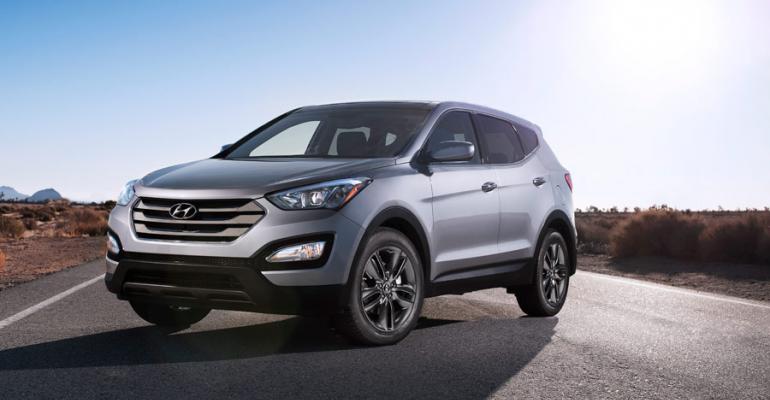NEW YORK – Hyundai debuts the next-generation Santa Fe midsize cross/utility vehicle, announcing that a 3-row, long wheelbase variant will replace the Veracruz large CUV in the Korean auto maker’s lineup.
“One of our core competencies is building a lot of different models off the same architecture, so we were able to do this inexpensively,” Hyundai U.S. CEO John Krafcik tells media at the auto show here.
The 3-row Veracruz has suffered from weak sales over the last five years since its launch in the U.S. market. Hyundai blames scant supplies from Korea rather than consumer indifference.
The 3-row ’13 Santa Fe, with a 3.9-in. (9.9-cm) longer wheelbase than the standard model, will debut in January. It will follow the late-summer launch of the 2-row version that Hyundai has dubbed the Santa Fe Sport.
The 2-row Santa Fe will be powered by the same 4-cyl. gasoline direct-injected engines as used in the Sonata midsize sedan, a 2.0L turbocharged mill and a 2.4L.
The 3-row model gets the 3.3L direct-injection V-6 employed by the new Azera large sedan, producing 290 hp in the long-wheelbase Santa Fe.
Hyundai estimates the 2.4L will achieve a peak 190 hp and 33 mpg (7.1 L/100 km) highway fuel economy. The 2.0L turbo engine will produce 264 hp and get 31 mpg (7.6 L/100 km) in Santa Fe models equipped with front-wheel drive and an automatic transmission.
The auto maker pegs the 3-row CUV’s highway fuel economy at 26 mpg (9.0 L/100 km).
Hyundai is upping the premium content available on the new Santa Fe, offering heated steering wheel, heated front and rear seats, a panoramic sunroof and several technologies to improve handling, including a torque-vectoring cornering-control system.
The latter works in conjunction with an optional all-wheel-drive system, delivering torque or braking force to a single wheel at any time to reduce unintended under- or oversteer, as well as improving lateral stability in cornering maneuvers. Hill-start assist and downhill braking control systems also are available on the ’13 CUVs.
A blind-spot-detection system, Hyundai’s first, will be available on 3-row Santa Fes.
Hyundai’s new Driver Selectable Steering mode technology, set to debut on the 5-door Elantra, makes its way into the new Santa Fe, allowing drivers to select normal, comfort or sport steering calibrations.
The auto maker touts many interior-space advantages over competing models, including giving the 3-row model more second-row legroom than the current Nissan Murano, Toyota Highlander and Chevy Traverse CUVs.
Hyundai says the increased use of ultra-high-strength steel allows for the largest generation-to-generation weight reductions in its history. The new Santa Fe FWD 2.4L and 2.0T will shed 266 lbs. (121 kg) and 300 lbs. (136 kg), respectively, compared with the current FWD 4-cyl. and V-6 Santa Fe CUVs.
Hyundai’s third-generation touchscreen navigation system debuts in the ’13 Santa Fe, with a simpler user interface and improved voice-recognition software that can understand a street address and city in one sentence, the auto maker says.
Hyundai has said a weak point for its brand is sales to families with young children, a common consumer of midsize and larger CUVs. The auto maker expects that situation to change with the 3-row variant.
“There’s so much flexibility now in that interior,” Krafcik says. “When you get in the 3-row Santa Fe, you’ll see how much stuff you can still put behind the third-row seat.”
The current Santa Fe undersells most competing models by a large margin, with deliveries through March of 14,535 units, compared with the Ford Edge’s 32,908, WardsAuto data shows.





